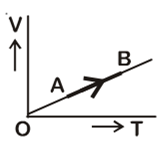 Multiple Choice Questions
Multiple Choice QuestionsA tuning fork is used to produce resonance in a glass tube. The length of the air column in this tube can be adjusted by a variable piston. At room temperature of 27ºC two successive resonances are produced at 20 cm and 73 cm of column length. If the frequency of the tuning fork is 320 Hz, the velocity of sound in air at 27ºC is
330 m/s
339 m/s
300 m/s
350 m/s
B.
339 m/s
Two successive resonance is produced at 20 cm and 73 cm of column length
A pendulum is hung from the roof of a sufficiently high building and is moving freely to and fro like a simple harmonic oscillator. The acceleration of the bob of the pendulum is 20 m/s2 at a distance of 5 m from the mean position. The time period of oscillation is
2πs
π s
1s
2s
The kinetic energies of a planet in an elliptical orbit about the Sun, at positions A, B and C are KA, KB and KC, respectively. AC is the major axis and SB is perpendicular to AC at the position of the Sun S as shown in the figure. Then

KA < KB < KC
KA > KB > KC
KB > KA > KC
KB < KA < KC
A solid sphere is in rolling motion. In rolling motion, a body possesses translational kinetic energy (Kt) as well as rotational kinetic energy (Kr) simultaneously. The ratio Kt: (Kt+ Kr) for the sphere is
7:10
5:7
2:5
10:7
A small sphere of radius 'r' falls from rest in a viscous liquid. As a result, heat is produced due to viscous force. The rate of production of heat when the sphere attains its terminal velocity, is proportional to
r3
r2
r4
r5
A sample of 0.1 g of water at 100°C and normal pressure (1.013 × 105 Nm–2) requires 54 cal of heat energy to convert to steam at 100°C. If the volume of the steam produced is 167.1 cc, the change in internal energy of the sample, is
104.3 J
208.7 J
84.5 J
42.2 J
Two wires are made of the same material and have the same volume. The first wire has cross-sectional area A and the second wire has cross-sectional area 3A. If the length of the first wire is increased by Δl on applying a force F, how much force is needed to stretch the second wire by the same amount?
9F
6F
F
4F
The power radiated by a black body is P and it radiates maximum energy at wavelength, λ0. If the temperature of the black body is now changed so that it radiates maximum energy at wavelength , the power radiated by it becomes nP. The value of n is
3/4
4/3
81/256
256/81
At what temperature will the rms speed of oxygen molecules become just sufficient for escaping from the Earth's atmosphere?
(Given: Mass of oxygen molecule (m) = 2.76 x 10-26 kg
Boltzmann's constant kB = 1.38 x 10-23 JK-1)
2.508 × 104 K
8.360 × 104 K
1.254 × 104 K
5.016 × 104 K
The volume (V) of a monatomic gas varies with its temperature (T), as shown in the graph. The ratio of work done by the gas, to the heat absorbed by it, when it undergoes a change from state A to state B, is

2/5
2/3
2/7
1/3
